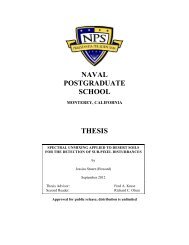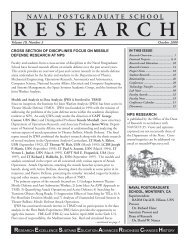High Energy Laser Testbed for Accurate Beam Pointing Control
High Energy Laser Testbed for Accurate Beam Pointing Control
High Energy Laser Testbed for Accurate Beam Pointing Control
Create successful ePaper yourself
Turn your PDF publications into a flip-book with our unique Google optimized e-Paper software.
For adaptive filters, the reference input needs to be coherent with the disturbance sources. Like classical time invariant<br />
control systems, adaptive filtering techniques can be applied using feed<strong>for</strong>ward or feedback. For a feed<strong>for</strong>ward system,<br />
the reference input is determined by measuring the disturbance. For feedback adaptive filters, the reference input is an<br />
estimation of disturbance from your system error. Typically, the filter output passes through the secondary plant (<strong>for</strong><br />
example corrective element such as FSM) prior to its effects being measured at the target sensor. The secondary plant<br />
will cause phase and gain variation. By placing a copy of the secondary plant transfer function in the reference signal<br />
path to the weight updating algorithm, such variations can be avoided. This is Filtered-X method [4]. At each time step,<br />
the weights must be updated to reduce the system error. There are two primary methods <strong>for</strong> updating weights, leastmean-square<br />
(LMS) and recursive-least-square (RLS).<br />
3.1.1 Recursive Least Mean Squares (LMS) Method<br />
The adaptive filter in Figure 15 can be written as<br />
where 0 1 2<br />
T<br />
y( n) = w ( n) r ( n)<br />
(8)<br />
( ) [ ( ), ( ), ( ),..., ( )] T<br />
w n = w n w n w n w n and ( ) [ ( ), ( 1),..., ( 1), ( )] T<br />
r n = r n r n− r n− M + r n−M . An<br />
easy way to quantify the system error is using the mean square of the error signal,<br />
M<br />
2<br />
ξ = Ee { ( n)}<br />
[2]. The LMS<br />
method uses a gradient of the error to determine the steepest descent <strong>for</strong> minimizing ξ . The upgraded weights are<br />
computed by the following equation:<br />
w( n+ 1) = w( n) + μr<br />
( n) e( n)<br />
(9)<br />
3.1.2 Recursive Least Mean Squares (RLS) Method<br />
Another method of updating the weighting vector is the use of recursive-lease-squares (RLS), which provides faster<br />
convergence and lower steady state errors than LMS. The RLS algorithm contains a cost function, which maintains a<br />
memory of errors according to a <strong>for</strong>getting factor of 0< λ ≤ 1.<br />
Where LMS method attempts to minimize the mean<br />
square of the current error, the RLS algorithm minimizes a summation of the square of all errors multiplied by the<br />
<strong>for</strong>getting factor, λ [4]:<br />
n<br />
n i 2<br />
( n) λ e ( i)<br />
i 1<br />
−<br />
= ∑<br />
=<br />
E (10)<br />
The purpose of the <strong>for</strong>getting factor is to more heavily weight recent data so that nonstationary disturbances can be<br />
accounted <strong>for</strong>. Equations (11), (12), and (13) summarize the FX-RLS algorithm <strong>for</strong> updating the weighting vector<br />
w( n)<br />
at each time step [4],[6].<br />
T<br />
w( n) = w( n− 1) + k ( n) e( n)<br />
(11)<br />
−1<br />
λ Q( n−1) rˆ(<br />
n)<br />
k(<br />
n)<br />
=<br />
+ λ rˆ n Q n− rˆ<br />
n<br />
−1<br />
T<br />
1 ( ) ( 1) ( )<br />
Q( n) = λ Q( n−1) −λ k( n) r ( n) Q ( n−1)<br />
(13)<br />
−1 −1<br />
T ˆ<br />
Another advantage of the RLS methods is that the weighting values will approach those of the optimal Wiener filter<br />
weightings, which is not the case <strong>for</strong> LMS [4].<br />
3.2 Narrow Field-of-View (NFOV) Video Tracker <strong>Control</strong> with Adaptive Filters<br />
Adaptive control was implemented on the NFOV using the video tracker error. This implementation is of the feedback<br />
type by estimating the disturbance from a video tracker error signal. The adaptive controller is added in series with the<br />
proportional-plus-integral (PI) controller. Additionally, both Filtered-X(FX)-LMS and Filtered-X(FX)-RLS adaptive<br />
Proc. of SPIE Vol. 7587 75870G-11<br />
Downloaded from SPIE Digital Library on 31 Jul 2012 to 205.155.65.56. Terms of Use: http://spiedl.org/terms<br />
(12)
















